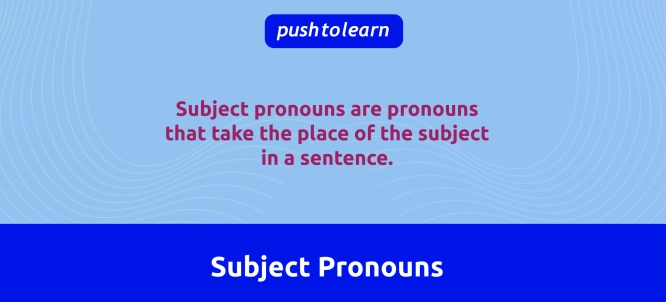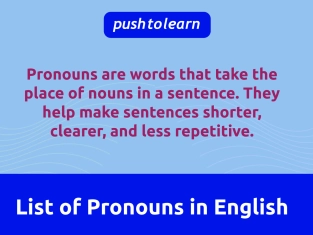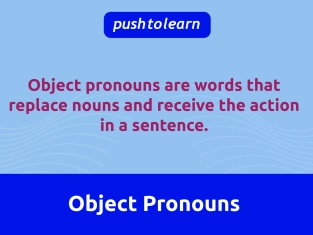by PushtoLearn
Subject Pronouns
Table of Contents
Subject Pronouns - Exercises
These exercises focus on Subject pronouns
What Are the Subject Pronouns?
In English, there are seven main subject pronouns:
|
Subject Pronoun |
Used for |
|
I |
the speaker (first person singular) |
|
you |
the person spoken to (second person singular and plural) |
|
he |
a male person (third person singular) |
|
she |
a female person (third person singular) |
|
it |
an object, animal, or thing (third person singular) |
|
we |
the speaker and others (first person plural) |
|
they |
people, animals, or things (third person plural) |

When to Use Each Subject Pronoun
-
I – Used when the speaker is referring to themselves.
-
Example: "I am going to the store."
-
You – Used when talking directly to one person or more than one person.
-
Example: "You are my best friend." / "You are all invited to the party."
-
He – Used to talk about a male person.
-
Example: "He is my brother."
-
She – Used to talk about a female person.
-
Example: "She loves reading books."
-
It – Used to talk about animals, objects, or things. We also use "it" for babies or when the gender is unknown.
-
Example: "It is raining." / "The dog is hungry; it needs food."
-
We – Used to talk about the speaker and one or more other people.
-
Example: "We are going to the park."
-
They – Used to talk about multiple people, animals, or things.
-
Example: "They are my friends." / "They are expensive shoes."
Examples of Subject Pronouns in Sentences
-
I – "I love painting."
-
You – "You look happy today."
-
He – "He plays soccer every weekend."
-
She – "She is studying for her exams."
-
It – "It is very cold outside."
-
We – "We will go to the movies together."
-
They – "They bought a new house."
Common Errors with Subject Pronouns
-
Using “it” instead of “he” or “she” for people:
-
Incorrect: "It is my friend."
-
Correct: "He is my friend." / "She is my friend."
-
Confusing “you” as singular or plural:
-
You can be either singular or plural, so it’s essential to look at context.
-
Example: "You are invited to the party." (could mean one person or a group)
-
Using “they” for a single object:
-
Incorrect: "They is a nice car."
-
Correct: "It is a nice car."
-
Forgetting to change verbs to match subject pronouns:
-
Incorrect: "He go to school."
-
Correct: "He goes to school."
Quick Table of Subject Pronouns with Examples
|
Pronoun |
Example Sentence |
|
I |
"I am learning English." |
|
you |
"You are a great cook." |
|
he |
"He works in an office." |
|
she |
"She dances beautifully." |
|
it |
"It looks like it will rain soon." |
|
we |
"We are planning a trip." |
|
they |
"They live near the beach." |
FAQ
Can “it” be used for people?
"It" is rarely used for people unless we don’t know their gender, such as in the case of a baby. However, it’s best to use "he" or "she" for individuals.
Can “you” mean more than one person?
Yes, "you" can be singular or plural. Context often makes it clear whether "you" is addressing one person or a group.
Is “they” used only for plural nouns?
No, "they" can be singular when talking about someone whose gender is unknown or non-binary. For example, "They are arriving soon" could refer to one person.
How do I know when to use “we” instead of “they”?
Use "we" if you are including yourself in the group. Use "they" if you’re talking about a group that doesn’t include you.
Can animals be “he” or “she” instead of “it”?
Yes, if the animal’s gender is known or if it’s a pet, people often use "he" or "she." For unknown animals, "it" is common.

